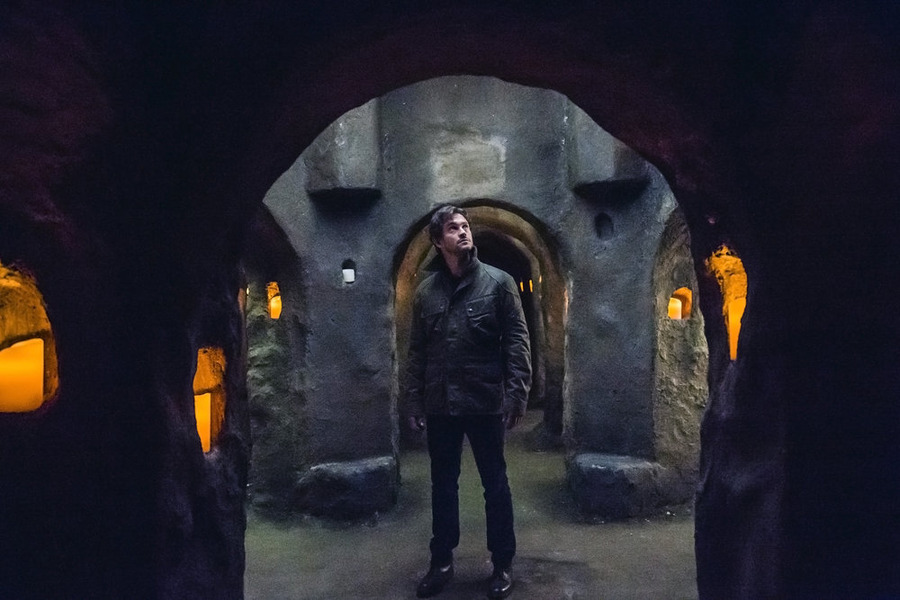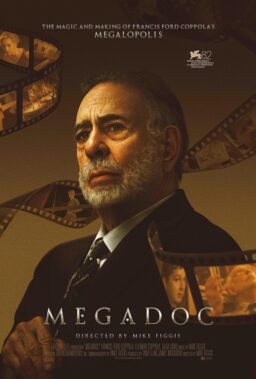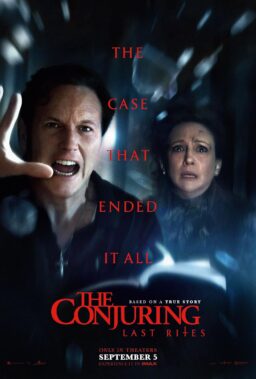NBC’s “Hannibal” is a black swan. It is a show that doesn’t
look like anything else on television, and, by all logic, shouldn’t exist,
especially not on traditional network TV. Working from the novels by
Thomas Harris and films like “Manhunter,” “The Silence of the Lambs,” and “Hannibal,”
creator Bryan Fuller has redefined a timeless character, and what we should
expect from a TV crime drama. After cutting his teeth as a writer for “Star
Trek: Deep Space Nine” and “Star Trek: Voyager,” Fuller created three beloved
series that weren’t given enough time to find a larger audience—“Dead Like Me,”
“Wonderfalls,” and “Pushing Daisies.” “Hannibal” seemed like his most daring
project to date, and the ratings suggested a similar brilliant-but-canceled
fate. And yet here we are headed into season three (which we’ll review on
Wednesday) and many critics, myself included, consider the program the best on network television. Mr. Fuller was kind enough to chat with us last week about where we
are, where we’re going, and how we got here.
From the chaos that
ended season two, how long ago did you know how we’d pick up in season three?
Was it planned out well in advance or after the finale?
It was well-planned, knowing partway through the season, that
we would leave everybody for dead. So about that time in season two, it seemed
the direct way for three would be to pick up directly where we left off, but
that wouldn’t be interesting enough for me, so I loved the idea of a time jump
where we go with the “victor” of the battle in season two and follow his
exploits without knowing who he’s laid to waste. That just felt like it was a
fun deviation from what would be expected. So, episode four is actually the
episode that picks up right after the finale and explains how everybody got to
where they are in the first part. I love non-linear storytelling. I think there’s
an opportunity to tell a tale with “emotional logic” as opposed to “plot logic.”
This is where this character is
emotionally and intellectually and their behavior is going to be informed by what
they’re feeling as opposed to what the plot is telling them to do.
I wouldn’t say that’s
new in season three, would you? It strikes me as a tenet of the show entirely.
Absolutely for this show. I felt in approaching this
material for the umpteenth time that the well had been gone to frequently. In
order to tell a different kind of story in a different kind of way, and avoid
slipping into restrictive parameters of the current procedural, it was necessary
to find other elements to enhance over the “killer of the week.” That’s why
over the first two seasons the “killer of the week” structure really became a
thematic umbrella under which we told a metaphorical story between Hannibal
Lecter and Will Graham.
There must have also
been pressure to cinematically approach the saga of Hannibal Lecter in ways
that Mann and Demme didn’t, for example. I’ve always felt the show had a deep
visual language. What were some of the cinematic influences—television or film—for
those choices?
There are so many. For the first two seasons, there were a
lot of David Cronenberg body dysmorphia elements that were fun to explore. It’s
always shocking to see the body transformed into something other than the vehicle
for our minds. Any time that happens, it’s disturbing and disorienting, and
makes you question your being and how you function. So that was a huge element
of how we told the crime procedural story.
I love the elegance of Stanley Kubrick and David Lynch.
They were very influential filmmakers for the series. As we go into season
three…one of my favorite movies from the ‘80s is “The Hunger,” the Tony Scott
film. It is this wonderfully decadent exploration of a European couple up to no
good. So, that was a huge influence coming into season three in the Italy
chapter—the symphony of abstract images intercut to tell a story that I saw in
that film that made my brain go bonkers when I was 13 or 14. There’s a lesbian
sex scene in episode six that’s absolutely inspired by Catherine Deneuve and
Susan Sarandon and takes it to a kaleidoscopic level of beauty in the female
form.
Earlier I was inspired by such diverse things as Busby
Berkeley—Wouldn’t it be interesting if
all of those people were dead? And also “Jeepers Creepers” when he falls
into the basement and sees the mural on the ceiling. Those things stick in my
craw and then find a way to get shaken out of my noggin onto the screen.
You don’t see a lot
of television inspired by “The Hunger.” How does NBC allow that kind of
inspiration, especially with the extreme degree of violence? Have you run into
any interference?
When we set out to do this show, Jen Salke, who’s the
President of NBC, sat across from me in her office and said, “I promise you I
will let you make the show you want to make.” And she’s kept that promise. That
is a rare thing in this industry. I’ve had it made to me before and seen it
easily broken. Jen Salke is a woman of her word and has kept the show on NBC
despite meager ratings. I’ve worked very closely with the Standards and
Practices team and our executive Joanna Jameson has been such a delight because
we both giggle when we’re talking about such strange things for broadcast television
and how much we can get away with. And she has always been there to say, “We
want you to make the show you want to make. We have to behave within these
parameters and I can help you navigate these parameters.” It’s been a mutually
respectful relationship and we would get that at no other broadcast network. I’ve
worked for ABC and FOX, and dealt with occasionally shocking restrictions on
things that are so mild in comparison to what we’ve done on “Hannibal” that it
is boggling to me.
I want to discuss how
you use the canon. Do you go back to Thomas Harris’ books regularly?
All the time.
Do you have signposts—we
want to get to this point in this episode—or do you use them more as reference
books?
I use them in a variety of ways. Oftentimes, there will be a
scene that we break into the story for the series and I’ll say, “This is a
scene from the book. You can just lift it out and put it on the page.” This is
one of those rare instances where we can just use what is there because it’s
GREAT. If I’m struggling with a scene and want to know what it’s about, I’ll
start reading one of the novels again depending on where we are. I’ll read
until I find a turn of phrase that inspires me. “That’s actually pertinent to
this scene. I can unpack that quote and build a scene out of that one line that’s
unexpected but allows us to stay true to our characters in this incarnation.” I’m
frequently referencing and quoting the books.
How do you maintain
such strong visual consistency across multiple episodes and multiple seasons?
With different directors, “Hannibal” has maintained such a strong visual
language, whether it be the specific angles of therapy scenes or the fetishization
of food. How do you keep that consistent every week?
It’s really about finding the right directors that want to
share the vision for the show. The first thing I tell any new director is “You
are making a pretentious art film.” This is not an episode of television. This
is a pretentious art film. It goes back to “The Hunger,” which is a pretentious
art film beautifully told. The criticisms at the time where that it was “style
over substance,” and I was like, “I’m getting plenty of substance, I don’t know
what you’re getting.” I love cinematic poetry. I love juxtaposition of imagery.
We have a wonderful second unit director named Chris Byrne, who shoots all of
our inserts and picks up all of the things we drop along the way. He’s got such a
wonderful commercial eye. We sit with him and say, “We need a drop of blood to
hit the carpet and splash upward in operatic fashion.” He can sort of transcend
the violence and take it into poetry. The thrust of the show is that the visual
poetry is so a part of what we do because the imagery needs to be as elegant
and eloquent as the title character.

How is this season
different visually or thematically than the last two?
The first season was the bromance, the second season was the
nasty break-up, the third season is that moment in a relationship after it has
ended where you need closure, and how you go about achieving that. There’s that
element in terms of Hannibal & Will. In a broader sense, this season has
jettisoned the traditional crime procedural storytelling element entirely. I’ve
never seen “Hannibal” as a crime story as much as I have a romantic horror
story.
I’ve never considered
it a crime story. I almost forgot that the first season had so many of those
standalone crime stories within it. That was kind of the set-up.
I had to do that to earn network trust in how we tell
stories, and to make an organic shift outside of that…you had to have explored
that thoroughly, so the network doesn’t say “Hey, our audience approaches every
show with an expectation of ingredients you must have in your dish.” There
certainly was an aspect of that in the first season when it was very important
to connect to an audience. When we got to the second season, we were picked up
more for its fan base and critical acclaim, and so there was greater leniency
and trust in how we were going to tell the story. By the time we got through
the second season, we had the network’s trust. We laid down exactly where we
were going to go and no one blinked.
I think it was
important to show Will and Jack and their colleagues doing their jobs as
character foundation so everything didn’t exist in a Hannibal-Will bubble. It
was valuable from a world creation standpoint as much as getting people into
the show.
Yes. The element of the FBI vs. Everything Else That’s
Happening is one where I’m constantly leaning toward character and away from
the investigatory. Even when we’re doing the “Red Dragon” arc, which is
essentially a 6-hour mini-series of the novel, it’s informed by the new
dynamics of the characters that have evolved over the last 2.5 seasons. It
allows us to triangulate the relationships between Will Graham, Hannibal
Lecter, and Francis Dollarhyde.
I heard a rumor that
you have six seasons sketched out for “Hannibal.” Is that true?
When it first started, I could see a 7-season arc. Nothing is
on paper. It’s all in my head. Those collapsed a little bit in season 3.
Originally, the intention was to be in Italy the entire season and that was not
realistic for our production model. It would have involved some water treading
in terms of the storytelling. Condensing what was the planned season 3 and 4
into one season actually made it much stronger. Condensing both of those arcs
gives us a creative drive to the storytelling that you don’t always get. There’s
two climaxes to the season. The storytelling feels tighter.
Before I let you go,
everyone wants to know anything about “Pushing Daisies.” Netflix, comic books,
Broadway show. Can you tell us ANYTHING at all?
There’s talks about a few things. I would LOVE to see a
limited Netflix series. I would love to see it on Broadway. Both of those things
are things that have been discussed and continue to be discussed. I’m hoping
that we get some traction on one of those fronts, mainly because it’s such a happy
universe for me to go to, particularly after working on “Hannibal” for three
years, which is not as life-affirming as “Pushing Daisies.” Of anything that I’ve
done, “Pushing Daisies” is most representative of my life view. I would love to
return to that world, and hope that that opportunity is afforded me.















